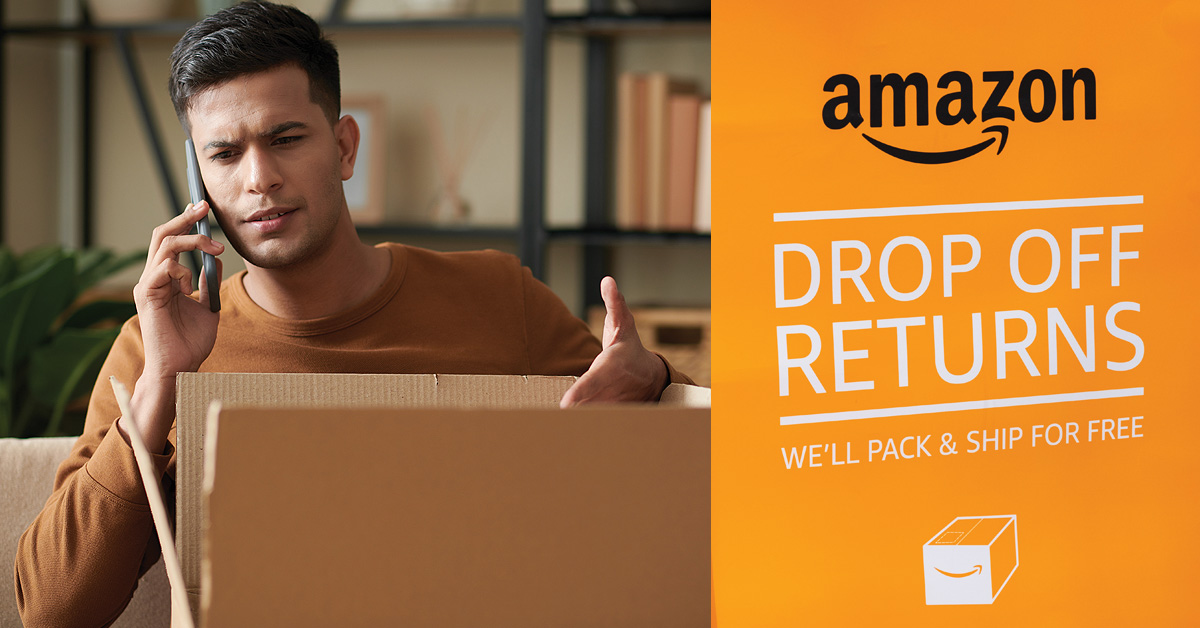
By Michelle Lopez
Buyer's remorse may be setting in as shoppers learn that the process of returning their unwanted purchases has been transforming over the last two years, with the end of free online returns emerging.
Amazon customers who once relied on free returns dropped off at any UPS store can now expect a $1 fee to send items back. And sellers on the platform will start seeing changes as well. Starting on June 1, 2024, Amazon will introduce a returns processing fee for high-return rate products in all categories, with fees ranging from $1.79 to up to $150 for extralarge items.
Helping sellers track their returns and the reasons why is a new tool that launched in 2023 called "Return Insights." Aside from the new fees, if items are frequently returned as defective, Amazon may even shut down the store. The aim is to ensure high-quality items are sold and item listings are optimized to include as much information as possible. On the buying side, customers are informed of "frequently returned items."
"The return policies for online shopping are central to letting the customers try out the products and if they don't like it, they can return it," said Sebastian Garcia-Dastugue, assistant teaching professor of marketing and logistics at FIU Business. "So basically, they're completely removing the risk away from the hands of the customer."
A popular online shopping hack referred to as "bracketing," where shoppers order multiples of a clothing item in different colors and sizes, so they can select only one item and return the rest is just one of the reasons returns are creating logistical nightmares.
In 2022, U.S. shoppers purchased $4.9 trillion and returned $743 billion in merchandise, with more than an estimated $100 billion worth of those items having been returned fraudulently, according to the National Retail Federation. The cost of handling a return is approximately 17% of the purchase cost, and this accounts for product handling, shipping and transportation costs. Other studies suggest it can go as high as 30% of the purchase cost.
Whether legitimate or fraudulent, processing the returned merchandise through the supply chain has become a pricey endeavor for businesses.
"The cost structure with the whole reverse logistics of shipping the product back to the company, having it reinspected to resell, or restocking it, or disposing of the product, there's just a ton of labor that's involved with all of that," said Jaclyn Tanenbaum, associate teaching professor of marketing and logistics at FIU Business.
Miami-based reverse logistics company goTRG handles returns for some of the top retailers and manufacturers in the country. It's also tasked with finding new buyers for the merchandise via business-tobusiness or business-to-consumer models.
"The process of maintaining the large influx of inventory is challenging at times," said Arturo Muino (BBA '19), senior recommerce manager for goTRG. "A higher rate of customer returns can increase storage costs, create overstocked warehouses and reduce employee efficiency. Making sure you have a proper way to manage these returns is crucial for a retailer to succeed and maximize its potential."
To hedge their losses on returns, some retailers can test out changes to their return policy to recuperate the costs for returns or dissuade customers from sending items back, while still trying to offer a frictionless experience for their customers.
"On the one hand, I want to make it easier for you to return the items so that you choose me as your preferred retailer," said Garcia-Dastugue. "The other column is, ‘if I don't put some barrier to the customer to return the product, then returns are going to be higher.' A little bit of a hurdle probably is not a bad idea."
A recent survey from goTRG shows that 60% of merchants have changed their return policies for online returns, with many eliminating free returns and 67% now charging additional shipping or restocking fees.
Aside from fees, others have turned to third-party drop-off locations, such as UPS stores, Whole Foods or Kohls, as used by Amazon.
Retailers should be aware that some recent studies have shown that some customers will not be deterred from buying online by a flat-rate restocking or returns fee. Other studies indicate that shoppers are bristling at the idea of more added fees.
"A higher rate of customer returns can increase storage costs, create overstocked warehouses and reduce employee efficiency. Making sure you have a proper way to manage these returns is crucial for a retailer to succeed and maximize its potential."
– Arturo Muino
"Whomever is able to produce a process for returning the products and for having the chance to refurbish them or salvage value from the return products, whoever does that the best will be able to offer more to the customer," said Garcia-Dastugue. "I think it's also an area of competition for retailers.
Returned and overstocked items with salvage value have seen a second chance at life at "bin stores." Independent and small chain bin stores purchase the returned goods from big-box retailers or liquidators at deep discounts and then resell for a small profit margin. The stores have been cropping up in the U.S. as the business model has taken off in the last three years. Consumers hunting for deals can search websites that track the store openings by state.
"With algorithms and built-in historical data to calculate fees and various costs, we can determine whether a product is to be sold wholesale directly to B2B clients or through B2C e-commerce sites," said Muino. "Once we determine the proper allocation for a product, we analyze market trends and follow pricing strategies to determine a good selling price for the item while making sure we have a healthy recovery versus the original MSRP."

Wendy Llorente (BBA '09), co-founder of Almara Beauty, an online retailer of natural skincare products, explained that the company hasn't processed any returns since its 2022 start. But its policy is displayed on its website.
"If you purchase any of our items, and either it doesn't sit well with your skin, or you just simply don't like it, we 100% give you back your money," said Llorente. "Obviously we don't want clients to use the entire face cream and say ‘Hey, I wasn't too happy with it.' You don't want to feel like you're being taken advantage of."
In terms of informing customers about return policies, or recent changes to the policies, it's best to let customers know, whether by displaying the policy on the website or printing it on the receipt.
"I think honesty is the best policy because in the end, you are trying to build a relationship with your customer base," said Tanenbaum. "Transparency is extremely important. No one wants to feel like they're being tricked. Make your policy based on whatever your rationality is but communicate it."
And when it comes to item descriptions, the more information the better. It's also a good opportunity for retailers to be upfront about some of the products that are frequently making their way back to them.
"They want the consumer to be more informed," said Tanenbaum. "Communicate — the more information you can provide to the customer, the better off they are."
New research conducted by Garcia- Dastugue found that having a lenient return policy can lead to good product reviews. Published in the Journal of Business Logistics, the research tracked the sales of an online toy retailer over a yearlong period. Certain sales were made during a period when the store offered a more lenient return policy.
Transactions were examined to see if buyers left reviews, how long the reviews were and the general tone. Results indicated that a lax return policy led to positive and detailed reviews, both of which are vital for businesses.
"Some reviews are increasingly important at the time of purchase because they become an element to help make the final decision to buy or not," Garcia- Dastugue said. "That shows they've become super important."
It may be a while before we see an end to merchandise return hurdles, so customers may want to focus more on retailers' policies before they commit to purchases.
For businesses, the key to avoiding returns might be a multi-faceted approach but providing clear item descriptions and customer reviews is an important start.
"Returns are here to stay," said Muino. "It's crucial to minimize these returns and use proper KPIs and metrics to monitor them in order to reduce costs and fees to a company's supply chain."
Developing and communicating a return policy that is efficient and easy for customers will ultimately keep them coming back.
"Retailers are trying to figure out how to level set," said Tanenbaum. "What's the best balance that the retailer can strike between being competitive and being accessible and being a good partner with their customer, but also to the point where the customer is not able to abuse it and go overboard?"